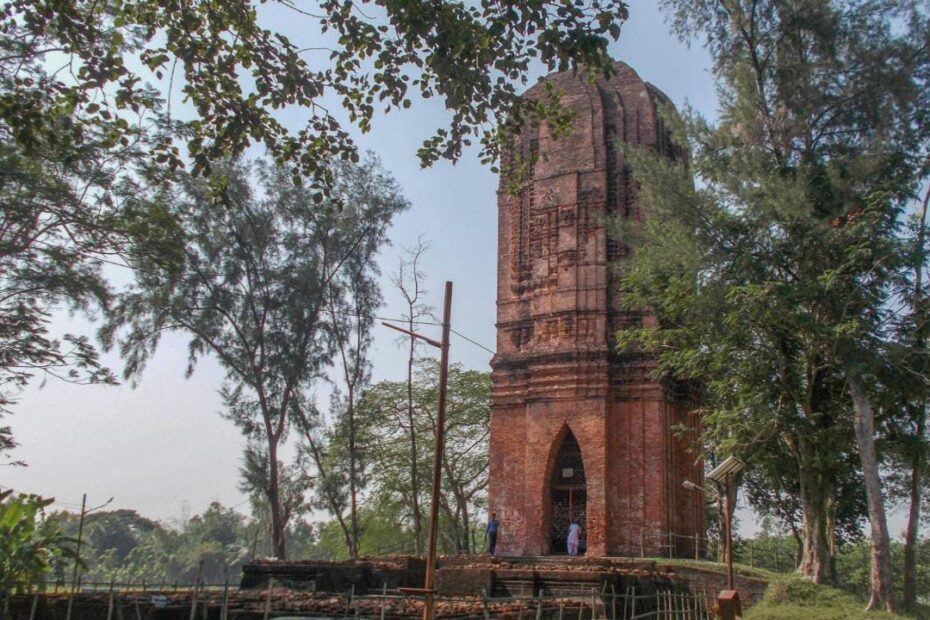West Bengal is a melting pot of rich cultures and stunning architecture. The architecture of some of the historical monuments is quite impressive.
It is indeed mesmerizing how Bengal and the adjacent states like Orissa have adopted the most flawless architectural styles during the reigns of different dominant rulers.
One such architectural element is “Deulas” built in the Hindu Temple in the Kalinga architectural style.
ADVERTISEMENT
There are different types of Deul styles and many temples in West Bengal with this Deula architecture element.
One such temple is the Jatar Deul, which is now a popular tourist spot in South 24 Paraganas.
In this article, you will get to know the following points about Jatar Deul,
Let’s see each of these points in detail…
How to reach Jatar Deul
There are many ways to reach Jatar Deul from Kolkata. The best and most affordable option is by train.
From Sealdah (South), board a train that heads towards Lakshmikantapur, and disembark at Mathurapur Road.
Take an auto from Mathurapur Road to reach Raidighi.
Again, take a motor van to Kankandighi from Raidighi.
The trip should only take approximately three hours. It may take up to 4 hours as well if you halt at Raidighi.
History of Jatar Deul
Jatar Deul stands as a lofty tall tower amidst the vast tract of farmland. The ancient monument is more of a watchtower than a temple.
Land surveyors discovered Jatar Deul in the middle of the nineteenth century when they came across this massive towering brick building hidden within the Sunderbans. The building itself was covered in dense vegetation.
The first doubt that struck the minds of the survey officials was who built this grand structure. Naturally, people questioned whether a thriving civilization existed in this region of Bengal.
ADVERTISEMENT
Despite the fact that historians have not been able to locate and dig up pieces of evidence of this temple-like structure, many of them have given different opinions.
Satishchandra Mitra in his book Jassore – Khulnar Itiash has described the temple as a watch tower of Pratapaditya.
Kashinath Dikshit claimed it as the architecture from the Mughal era but subsequently identified it as an Oriya architecture from earlier times of Konark and Lingaraj.
In 1914 J. F Blackistone who was the head of ASI’s Eastern Region initially called the building “timeless,” but later claimed that the structure was built during the Pal-Sen era or roughly 1000 AD.
According to a copper plate discovered in 1875 close to the temple, Raja Joychandra Constructed this temple In the year 975 AD.
The plate has long been missing, but its presence was once more confirmed by eminent Sundarban historian Kalidas Dutta. Many historians were still doubtful as they were no evidence of written records about Joychandra.
Architecture of Jatar Deul
Jatar Deul adopts the Oriya style of the colossal spire, “Deul,” rather than the conventional Bengali style of Chala or Ratna.
The locals believe that the long-abandoned temple once housed the goddess of Shiva with matted hair (Jatadhari), hence the name “Jatar Deul.”
Outer Structure
The temple’s square base is 25.5 feet in size. The inner sanctum is a square as well, with its side measuring 10 feet 8 inches, and it is situated 4 feet 3 inches below ground.
Five Kulingis can be found in the inner sanctuary.
The original spire was damaged by an Englishman who was looking for a hidden treasure, so it was impossible to determine the exact height of the temple.
ADVERTISEMENT
The spire is constructed using the corbelling method, which involves arranging bricks in steps.
Despite being rebuilt, the spire regrettably lacks the grace and beauty of its original counterpart.
Sadly, most of the intricate decorative brickwork on the temple’s walls has been lost due to unplanned construction.
Inner structure
And now that you know about the flawless exterior appearance of the Jatar Deul made of Terracotta, let me tell you about the interior of the Deula.
The inside of the temple is quite simple. The inner Sanctorum or the “Garbagriha” and “Jagmahona” are built in the typical Oriya architectural styles.
The main deity is Lord Shiva, although there are various pictures and idols of other deities too.
2-3 brass bells are located inside.
There is a very simple platform of brick where the god is worshipped!
Best time to visit Jatar Deul
You can visit Jatar Deul during any time of the year, but I would recommend you to visit during the summer months of April, particularly for a reason.
Every year on the 2nd day of Baisakh ( in mid-April) an enigmatic horse race takes place near the Deul. The horse race starts from the temple and completes a route before it ends at the temple.
ADVERTISEMENT
A big fair is also held during this time. The villagers from the nearby villages visit the place for watching the horse race.
Other entertainment activities like singing, dancing, and rural dramas (Jatra)are also held during this time.
There are many unexplored monuments like the Jatar Deul in the lap of West Bengal.
The hidden historical treasures can dig up much evidence of the past as well.
The architectural excellence revealed by these offbeat historical landmarks needs more light so that these places gradually grow into significant tourist destinations.
Cover Photo Credits: Paramanu Sarkar, CC BY-SA 4.0, via Wikimedia Commons
Some other articles you might like
- Neora Jungle Camp (Lataguri) – How To Book, Accommodations
- Jayanti (Dooars) West Bengal – Attractions, Best Time To Visit
- Abanindranath Tagore’s Garden House | Konnagar Bagan Bari
- 8 Best Places For A One Day Tour From Kolkata 2024
- Chandannagar Museum (Hooghly) – Timings, Ticket Price, History
- 4 Best Places To Visit In Bolpur-Shantiniketan (West Bengal)
Disclaimer: Some of the links provided in the article may contain affiliate links. This means when you book or buy something using these links, you help support the website at no extra cost.
